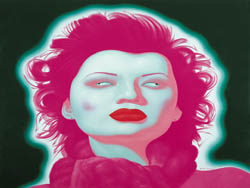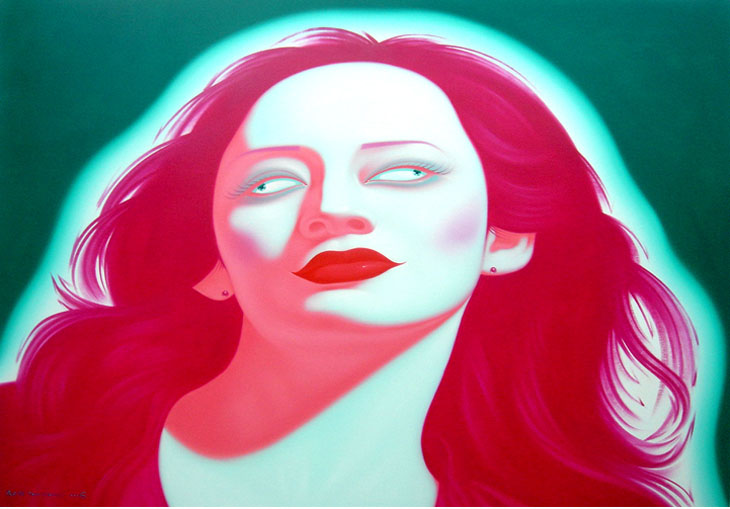
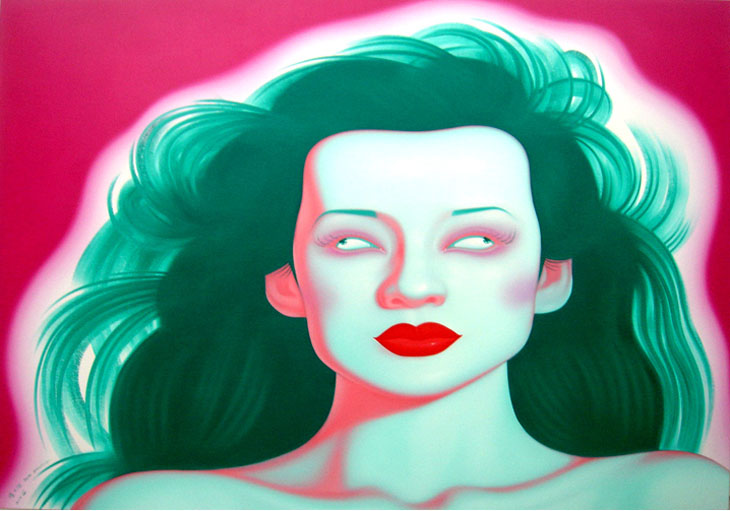
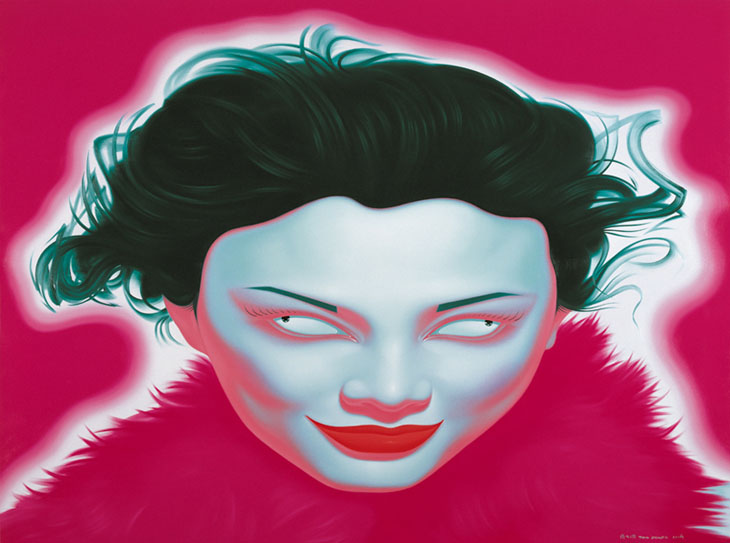
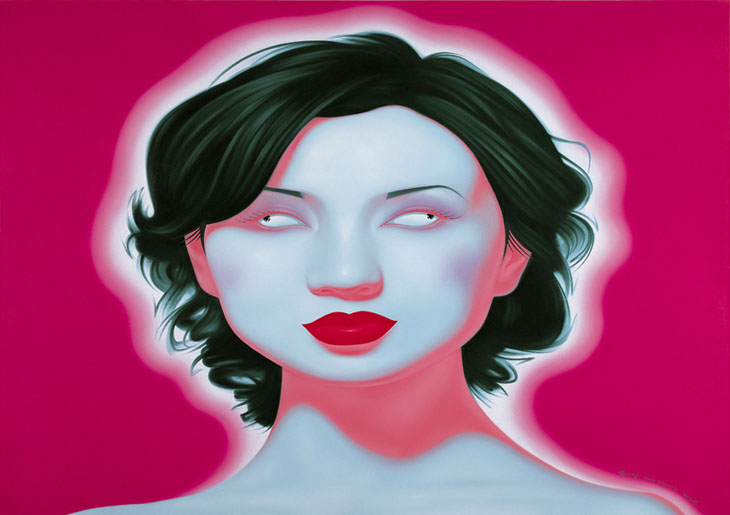

ARTIST:
Feng Zhengjie
Reminiscent of Warhol’s screen printed celebrities, Feng’s paintings reflect a vision of futuristic pop. His generic portraits of women are influenced by promotional imagery: their exotic colours, electrified auras, and wind machine hair exude the glamour aesthetic of commodified desire. Feng appropriates these staples of western kitsch as a readymade lingo for a duplicity of ideology. His work is often discussed as capitalist critique, his empty eyed models posing as frivolous and vacant signifiers. Neither western nor Chinese in appearance, Feng’s femmes fatales are a super-hybrid of commercial beauty, a science fiction product of globalisation.
Painted in massive scale, Feng’s canvases replicate the billboards from which they were inspired. Without text, or accompanying products, Feng’s paintings streamline their hard-sell ethos. Removing all distraction, he exposes the essence of temptation, magnifying the sex appeal of fantasy lifestyle and its gulf of intangibility. Transposing these disposable sentiments through his highly refined painting technique, Feng glorifies the allure of advertising as epic, enduring, and numbingly empty. Reminiscent of Warhol’s screen printed celebrities, Feng’s paintings reflect a vision of futuristic pop. His generic portraits of women are influenced by promotional imagery: their exotic colours, electrified auras, and wind machine hair exude the glamour aesthetic of commodified desire. Feng appropriates these staples of western kitsch as a readymade lingo for a duplicity of ideology. His work is often discussed as capitalist critique, his empty eyed models posing as frivolous and vacant signifiers. Neither western nor Chinese in appearance, Feng’s femmes fatales are a super-hybrid of commercial beauty, a science fiction product of globalisation.
Painted in massive scale, Feng’s canvases replicate the billboards from which they were inspired. Without text, or accompanying products, Feng’s paintings streamline their hard-sell ethos. Removing all distraction, he exposes the essence of temptation, magnifying the sex appeal of fantasy lifestyle and its gulf of intangibility. Transposing these disposable sentiments through his highly refined painting technique, Feng glorifies the allure of advertising as epic, enduring, and numbingly empty. Reminiscent of Warhol’s screen printed celebrities, Feng’s paintings reflect a vision of futuristic pop. His generic portraits of women are influenced by promotional imagery: their exotic colours, electrified auras, and wind machine hair exude the glamour aesthetic of commodified desire. Feng appropriates these staples of western kitsch as a readymade lingo for a duplicity of ideology. His work is often discussed as capitalist critique, his empty eyed models posing as frivolous and vacant signifiers. Neither western nor Chinese in appearance, Feng’s femmes fatales are a super-hybrid of commercial beauty, a science fiction product of globalisation.
Painted in massive scale, Feng’s canvases replicate the billboards from which they were inspired. Without text, or accompanying products, Feng’s paintings streamline their hard-sell ethos. Removing all distraction, he exposes the essence of temptation, magnifying the sex appeal of fantasy lifestyle and its gulf of intangibility. Transposing these disposable sentiments through his highly refined painting technique, Feng glorifies the allure of advertising as epic, enduring, and numbingly empty.
Painted in massive scale, Feng’s canvases replicate the billboards from which they were inspired. Without text, or accompanying products, Feng’s paintings streamline their hard-sell ethos. Removing all distraction, he exposes the essence of temptation, magnifying the sex appeal of fantasy lifestyle and its gulf of intangibility. Transposing these disposable sentiments through his highly refined painting technique, Feng glorifies the allure of advertising as epic, enduring, and numbingly empty. Reminiscent of Warhol’s screen printed celebrities, Feng’s paintings reflect a vision of futuristic pop. His generic portraits of women are influenced by promotional imagery: their exotic colours, electrified auras, and wind machine hair exude the glamour aesthetic of commodified desire. Feng appropriates these staples of western kitsch as a readymade lingo for a duplicity of ideology. His work is often discussed as capitalist critique, his empty eyed models posing as frivolous and vacant signifiers. Neither western nor Chinese in appearance, Feng’s femmes fatales are a super-hybrid of commercial beauty, a science fiction product of globalisation.
Painted in massive scale, Feng’s canvases replicate the billboards from which they were inspired. Without text, or accompanying products, Feng’s paintings streamline their hard-sell ethos. Removing all distraction, he exposes the essence of temptation, magnifying the sex appeal of fantasy lifestyle and its gulf of intangibility. Transposing these disposable sentiments through his highly refined painting technique, Feng glorifies the allure of advertising as epic, enduring, and numbingly empty. Reminiscent of Warhol’s screen printed celebrities, Feng’s paintings reflect a vision of futuristic pop. His generic portraits of women are influenced by promotional imagery: their exotic colours, electrified auras, and wind machine hair exude the glamour aesthetic of commodified desire. Feng appropriates these staples of western kitsch as a readymade lingo for a duplicity of ideology. His work is often discussed as capitalist critique, his empty eyed models posing as frivolous and vacant signifiers. Neither western nor Chinese in appearance, Feng’s femmes fatales are a super-hybrid of commercial beauty, a science fiction product of globalisation.
Painted in massive scale, Feng’s canvases replicate the billboards from which they were inspired. Without text, or accompanying products, Feng’s paintings streamline their hard-sell ethos. Removing all distraction, he exposes the essence of temptation, magnifying the sex appeal of fantasy lifestyle and its gulf of intangibility. Transposing these disposable sentiments through his highly refined painting technique, Feng glorifies the allure of advertising as epic, enduring, and numbingly empty.




